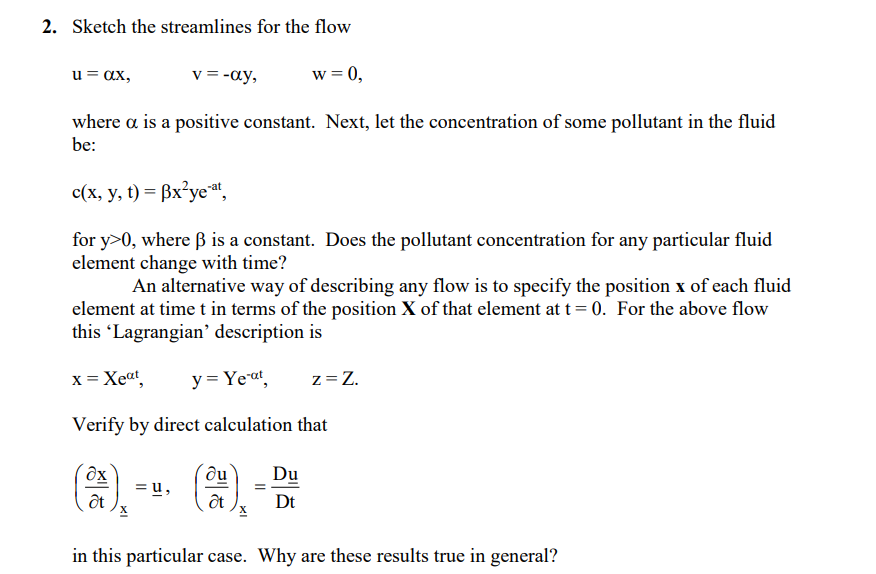2. Sketch the streamlines for the flow u = ax, v = -ay, w = 0, where a is a positive constant. Next, let the concentration of some pollutant in the fluid be: с(х, у, t) %3D Вx?уе, for y>0, where B is a constant. Does the pollutant concentration for any particular fluid element change with time? An alternative way of describing any flow is to specify the position x of each fluid element at time t in terms of the position X of that element at t= 0. For the above flow this Lagrangian' description is x = Xeat, y = Yeat z= Z. Verify by direct calculation that əx Du = u, Dt in this particular case. Why are these results true in general?
2. Sketch the streamlines for the flow u = ax, v = -ay, w = 0, where a is a positive constant. Next, let the concentration of some pollutant in the fluid be: с(х, у, t) %3D Вx?уе, for y>0, where B is a constant. Does the pollutant concentration for any particular fluid element change with time? An alternative way of describing any flow is to specify the position x of each fluid element at time t in terms of the position X of that element at t= 0. For the above flow this Lagrangian' description is x = Xeat, y = Yeat z= Z. Verify by direct calculation that əx Du = u, Dt in this particular case. Why are these results true in general?
Linear Algebra: A Modern Introduction
4th Edition
ISBN:9781285463247
Author:David Poole
Publisher:David Poole
Chapter4: Eigenvalues And Eigenvectors
Section4.6: Applications And The Perron-frobenius Theorem
Problem 69EQ: Let x=x(t) be a twice-differentiable function and consider the second order differential equation...
Related questions
Question
100%

Transcribed Image Text:2. Sketch the streamlines for the flow
v = -ay,
w = 0,
u = ax,
where a is a positive constant. Next, let the concentration of some pollutant in the fluid
be:
c(x, y, t) = ßx²yet,
for y>0, where ß is a constant. Does the pollutant concentration for any particular fluid
element change with time?
An alternative way of describing any flow is to specify the position x of each fluid
element at time t in terms of the position X of that element at t= 0. For the above flow
this Lagrangian' description is
x = Xeat,
y = Yeat
z= Z.
Verify by direct calculation that
du
= u,
ốt
Du
Dt
in this particular case. Why are these results true in general?
Expert Solution
This question has been solved!
Explore an expertly crafted, step-by-step solution for a thorough understanding of key concepts.
This is a popular solution!
Trending now
This is a popular solution!
Step by step
Solved in 3 steps with 1 images

Recommended textbooks for you

Linear Algebra: A Modern Introduction
Algebra
ISBN:
9781285463247
Author:
David Poole
Publisher:
Cengage Learning

Linear Algebra: A Modern Introduction
Algebra
ISBN:
9781285463247
Author:
David Poole
Publisher:
Cengage Learning